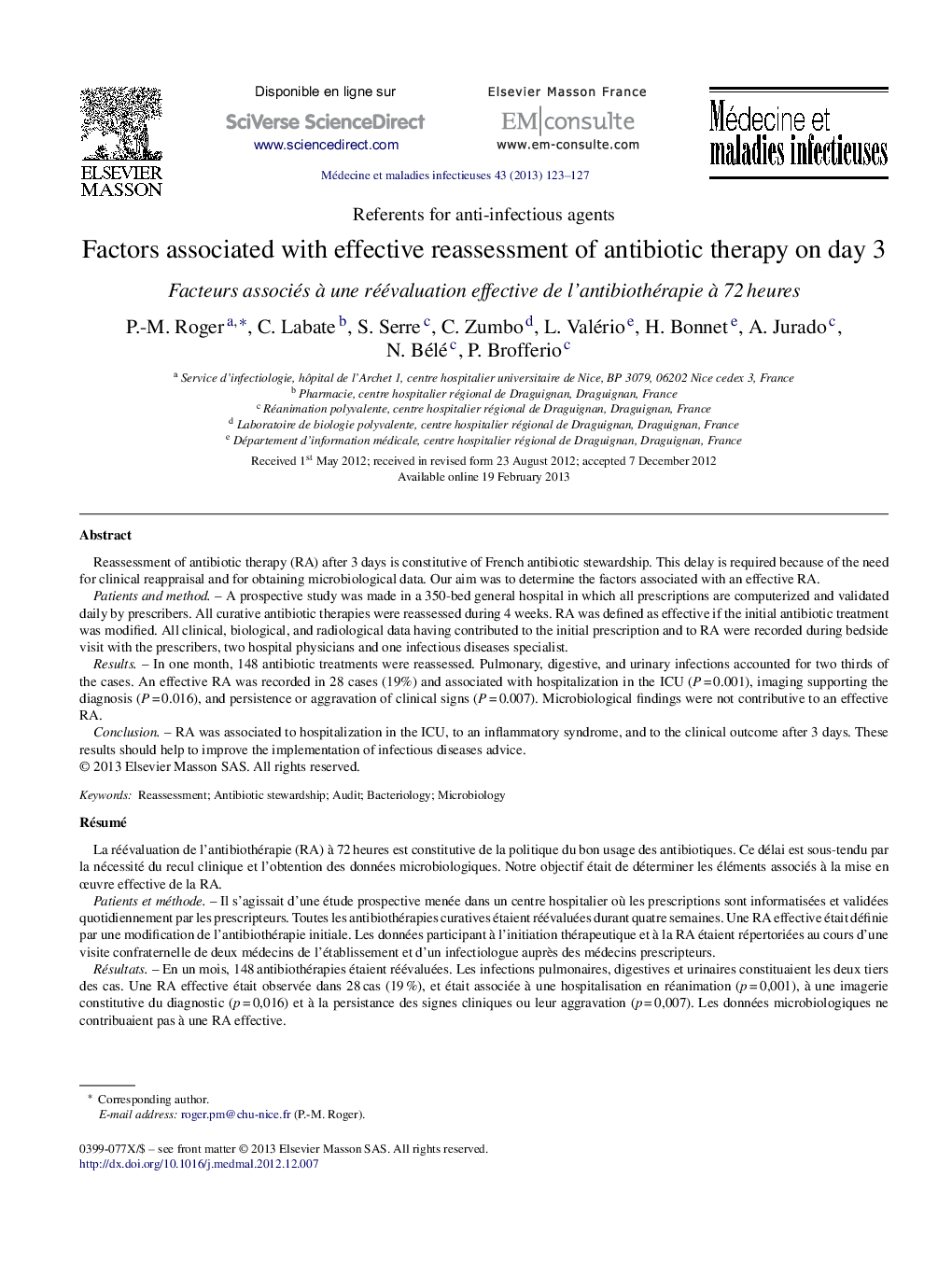| کد مقاله | کد نشریه | سال انتشار | مقاله انگلیسی | نسخه تمام متن |
|---|---|---|---|---|
| 3412743 | 1224247 | 2013 | 5 صفحه PDF | دانلود رایگان |

Reassessment of antibiotic therapy (RA) after 3 days is constitutive of French antibiotic stewardship. This delay is required because of the need for clinical reappraisal and for obtaining microbiological data. Our aim was to determine the factors associated with an effective RA.Patients and methodA prospective study was made in a 350-bed general hospital in which all prescriptions are computerized and validated daily by prescribers. All curative antibiotic therapies were reassessed during 4 weeks. RA was defined as effective if the initial antibiotic treatment was modified. All clinical, biological, and radiological data having contributed to the initial prescription and to RA were recorded during bedside visit with the prescribers, two hospital physicians and one infectious diseases specialist.ResultsIn one month, 148 antibiotic treatments were reassessed. Pulmonary, digestive, and urinary infections accounted for two thirds of the cases. An effective RA was recorded in 28 cases (19%) and associated with hospitalization in the ICU (P = 0.001), imaging supporting the diagnosis (P = 0.016), and persistence or aggravation of clinical signs (P = 0.007). Microbiological findings were not contributive to an effective RA.ConclusionRA was associated to hospitalization in the ICU, to an inflammatory syndrome, and to the clinical outcome after 3 days. These results should help to improve the implementation of infectious diseases advice.
RésuméLa réévaluation de l’antibiothérapie (RA) à 72 heures est constitutive de la politique du bon usage des antibiotiques. Ce délai est sous-tendu par la nécessité du recul clinique et l’obtention des données microbiologiques. Notre objectif était de déterminer les éléments associés à la mise en œuvre effective de la RA.Patients et méthodeIl s’agissait d’une étude prospective menée dans un centre hospitalier où les prescriptions sont informatisées et validées quotidiennement par les prescripteurs. Toutes les antibiothérapies curatives étaient réévaluées durant quatre semaines. Une RA effective était définie par une modification de l’antibiothérapie initiale. Les données participant à l’initiation thérapeutique et à la RA étaient répertoriées au cours d’une visite confraternelle de deux médecins de l’établissement et d’un infectiologue auprès des médecins prescripteurs.RésultatsEn un mois, 148 antibiothérapies étaient réévaluées. Les infections pulmonaires, digestives et urinaires constituaient les deux tiers des cas. Une RA effective était observée dans 28 cas (19 %), et était associée à une hospitalisation en réanimation (p = 0,001), à une imagerie constitutive du diagnostic (p = 0,016) et à la persistance des signes cliniques ou leur aggravation (p = 0,007). Les données microbiologiques ne contribuaient pas à une RA effective.ConclusionLa RA était associée à un séjour en réanimation, au syndrome inflammatoire et à l’absence d’amélioration clinique à j3. Ces informations devraient permettre d’améliorer la mise en œuvre du conseil en antibiothérapie.
Journal: Médecine et Maladies Infectieuses - Volume 43, Issue 3, March 2013, Pages 123–127